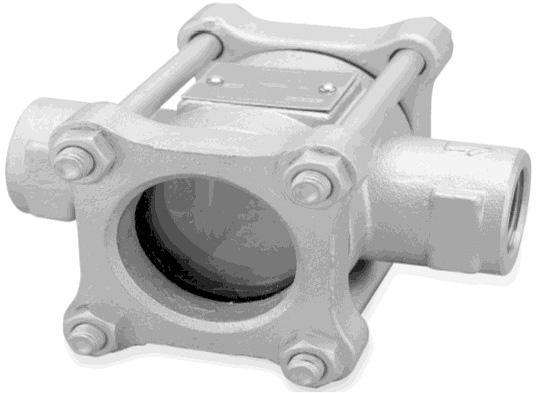-
Steam Trap Maintenance and Management
-
Steam Trap Diagnosis
-
-
-
-
Current situation regarding the steam trap diagnoses
The steam trap diagnosis needs to be performed promptly without stopping factory operation. It is not practical to spend sufficient time on diagnosis of each steam trap unit, at least not for periodic investigations.
In other words, the diagnosis should be performed based on external information such as surface temperature and trap body vibration. In addition, prompt diagnosis is required from the viewpoint of reducing work time and labor. The average number of units to be diagnosed per day is around 150, which is the actual workload standard.150.
-
-
Normal operation
There are two types of steam trap operation depending on the valve function, continuous operation and intermittent operation. Continuous operation is the type in which condensate is discharged continuously by adjusting the valve opening according to the amount of flowing condensate. In the intermittent operation type, condensate is generated in the trap body or upstream of it to a certain extent, and then discharged all at once. (For operating characteristics, see "Operating Characteristics of Steam Traps.")
Therefore, normally operating steam traps discharge condensate continuously as long as condensate is created in the case of continuous operation type, and discharge vigorously while making emitting operating noise (for some seconds) in the case of intermittent operation type.
Regardless of the operating characteristics, the temperature at the inlet of a normal steam trap is "close to the saturated steam temperature of the operating pressure.
The main types of steam trap can be divided as follows, according to operating features.
-
- Continuous operation type: ball float type, thermostatic type (including temperature control trap)
-
- Intermittent operation type: Bucket type, Disc type
How to distinguish failed steam traps
There are two kinds of steam trap failure, blockages and steam leakage.
-
1) How to distinguish blocked steam traps
-
If the steam trap is blocked, the temperature of the trap inlet part clearly drops, and in the case of a complete blockage, it becomes almost equal to the ambient temperature. Therefore, diagnosis can be simply performed by checking the surface temperature of the trap inlet.
-
-
2)How to distinguish steam leakage
Although there is a significant difference in the degree of steam leakage from the initial stage (start of leakage) to the final stage (blowout), the check is generally done using one of two methods: visual inspection or vibration detection (or listening for vibration sound).
○ Visual judgement
For the visual inspections, the steam trap must be open to the atmosphere or in another state in which the discharge part can be observed. The presence or absence of live steam can be judged visually, but it may be difficult to determine if it requires some experience.
If it is not possible to observe the discharge section due to condensate recovery, it is possible to judge visually if a sight glass is installed such as figure 6.2.

Figure 6.2 Sight glass
○ Checking for vibrations (sound)
Vibration can be checked using a stethoscope or vibroscope.
The vibration (sound) from the steam trap during a steam leak has a different frequency from that during condensate discharge.
A Stethoscope is a tool that can detect sound differences based on frequency differences. On the other hand, a vibroscope is a tool for quantifying the signal of a vibration sensor according to acceleration of frequency and frequency of vibrations.
Although steam leaks can be judged using these tools; however, such judgment may be difficult depending on the types of steam traps and the conditions of use. In this case, it is necessary to make a comprehensive judgment considering the surrounding conditions.
-
-
-
Basic steam trap survey procedures
-
Steam trap diagnoses are basically performed using the following procedure with a surface heat gauge, stethoscope, or vibroscope.
-
1) Visual judgement
When discharge section of the steam trap is open to the atmosphere, first observe the steam discharge conditions visually to judge whether there is steam leakage or not. At the same time, check whether the valve is open or closed if is installed in an inlet line.
-
-
2) Checking surface temperature
If nothing has been drained from the outlet, and visual judgement cannot be performed, you should check the surface temperature in the steam trap inlet. If the temperature has decreased significantly compared to the saturated steam temperature (set temperature in the case of temperature control trap), it is judged to be blocked. At that time, the status is shut-down if the initial valve is closed, and should be diagnosed at a later date.
-
-
3) Check the vibrations (sound)
If it is not blocked or shut down, you should investigate the vibrations (sound) surveyed. In the case of intermittent operation type, it should be checked when the valve is closed.
-
-
4) Overall judgment
If the existence of steam leak cannot be judged by vibration (sound) check, judge it in a comprehensive way, considering vibration change (flow change), operating condition of primary side equipment, and others. If it is still difficult to make a judgment, you will need to ask for advices and judgment of the trap manufacturer or other person with extensive experience in inspection.
Miyawaki is a manufacturer that also provides such diagnostic services, and we respond to a wide variety of requests, ranging from customer-driven voluntary inspections to outsourced inspections.